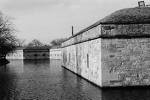 I belong to an email group interested in the preservation of Fort Monroe. http://www.cfmnp.org/
I belong to an email group interested in the preservation of Fort Monroe. http://www.cfmnp.org/ I recently received this email which I thought I'd share with other genealogists as we all should be interested in preserving our historic sites.
"Yesterday at the National Press Club near the White House, the Civil War Preservation trust affirmed for the third time that Fort Monroe is a threatened national treasure.
The CWPT's press release says that its annual "most endangered" report for 2009 "presents the 10 most endangered battlefields in the nation ... [and] briefly describes the 15 additional 'at risk' sites that round out the top 25 endangered Civil War battlefields in the United States.
"Fort Monroe is in the "at-risk" tier among those "top 25 endangered" sites.Unfortunately, the Associated Press misreported the news about the 15 "at risk" sites.
For the best coverage, please see Clint Schemmer's article in the Fredericksburg Free-Lance Star:http://www.fredericksburg.com/News/FLS/2009/032009/03192009/453325
(Fort Monroe is specifically cited at the end of the listings sidebar.)
Thanks very much.
Steve Corneliussen - Citizens for a Fort Monroe National Park (CFMNP.org)"

History of Fort Monroe
Fort Monroe was built between 1819 and 1834, but as early as 1608, Captain John Smith recognized the importance of building a fort at Point Comfort, as the English colonists called this land. In 1609 they built Fort Algernourne here, with the mission of protecting the approaches to the colony at Jamestown. Throughout the colonial period, there were other fortifications at this site, but none lasted very long.
When the United States entered the War of 1812 against Great Britain, the young nation soon found that its old systems of defense were inadequate to protect its coasts and port cities. The capture and burning of Washington, D.C. in 1814 was a hard lesson. But from that experience grew a new system of coastal defenses, of which the first and largest was Fort Monroe.
Fort Monroe's original mission was to protect the entrance to Hampton Roads and the several port cities that had access to its waters. The fort accomplished this mission by mounting an impressive complement of the most powerful artillery of the time, 32-pounder guns with a range of over one mile. This was just enough range to cover the main shipping channel into the area. In 1824, the fort received another important mission when it was chosen as the site for the Army's new Artillery School of Practice.
During the Civil War, Fort Monroe was quickly reinforced so that it would not fall to Confederate forces. In cooperation with the Navy, troops from Fort Monroe extended Union control along the coasts of the Carolinas. Several land operations against Confederate forces also were mounted from the fort, notably the battle of Big Bethel in June 1861, Major General George McClellan's Peninsula Campaign of 1862 and the siege of Suffolk in 1863. In 1864 the Army of the James was formed at Fort Monroe. Fort Monroe is also the place at which Major General Benjamin Butler made his famous "contraband" decision, by which escaping slaves reaching Union lines would not be returned to bondage. Former Confederate President, Jefferson Davis, was a prisoner here for two years.
Over time the armament at the fort was improved, taking advantage of new technologies. In addition, the fort controlled several subinstallations around Hampton Roads, making the area one of the most heavily defended in the United States. By World War II Fort Monroe served as headquarters for an impressive array of coast artillery guns ranging from 3-inch rapid fire guns to 16-inch guns capable of firing a 2,000 pound projectile 25 miles. In addition, the Army controlled submarine barriers and underwater mine fields. But this vast array of armaments was all made obsolete by the development of the long-range bomber and the aircraft carrier.
After the operational armament was removed, Fort Monroe received a mission that it still maintains to this day. Since World War II the major headquarters that have been stationed here have all been responsible for training soldiers for war. Since 1973 Fort Monroe has been home to the Training And Doctrine Command.
source: www.monroe.army.mil


















4 comments:
I love all the history on your blog. It's a great blog. Welcome to Geneabloggers.
Thank you. Glad it is readable. I appreciate your comment. T.
Thanks very much for reporting Fort Monroe's endangerment to the readers of this blog, who of course are among that national treasure's actual owners -- though you can't always tell that citizens own Fort Monroe from the way that the Fort Monroe decision-makers are making their decisions. If I may, I'd like to note one thing about the Fort Monroe historical summary that's posted along with the endangerment message of mine that appears above. One sentence says that Fort Monroe is where "Major General Benjamin Butler made his famous 'contraband' decision, by which escaping slaves reaching Union lines would not be returned to bondage." It's true that what the general did was clever, constructive, and important. But in my view, our evolving understanding of the past requires us to see that what the first three Contrabands did, and indeed what every Contraband did, was even more important. Gen. Butler invoked the laws of war and the obscene, grotesque laws that said that humans could be property. But Frank Baker, James Townsend and Sheppard Mallory -- the first three Contrabands, whose names ought to be stated, in my view -- invoked something higher when they took the initiative and the risk to escape enslavement and ask for sanctuary at Fort Monroe. They invoked the Laws of Nature and of Nature's God. In doing that, they validated that some truths are self-evident, and thereby validated the purposes of the Civil War. In sum, then, what I'm saying is that Fort Monroe would be important just as green space even if it were not historically important, but in fact it is vitally historically important because it's the place where slavery began to die. I hope readers of this blog will subscribe to our e-mail updates by going to the Citizens for a Fort Monroe National Park Web site shown with this message. (And I also hope the blog owner will delete my personal e-mail address before the spam robots pick it up! Better to use the "contact" address that's on the CFMNP home page.) Thanks very much. -Steve Corneliussen, Citizens for a Fort Monroe National Park -- Advocating a self-sustaining, revenue-generating Grand Public Place at Old Point Comfort
To Steve: Will do! I apologize; my error. Thank you for reminding me about the bot problem. I hope this blog is helpful in spreading the news abt http://www.cfmnp.org/
Post a Comment